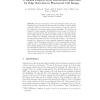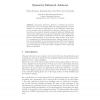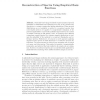ISVC
2010
Springer
14 years 10 months ago
2010
Springer
We present a novel framework to reliably learn scene entry and exit locations using coherent motion regions formed by weak tracking data. We construct “entities” from weak trac...
109
click to vote
ISVC
2010
Springer
14 years 10 months ago
2010
Springer
We extend our previous work on the exploration of static metabolic networks to evolving, and therefore dynamic, pathways. We apply our visualization software to data from a simulat...
103
click to vote
ISVC
2010
Springer
14 years 10 months ago
2010
Springer
Dealing with multi-object tracking in a particle filter raises several issues. A first essential point is to model possible interactions between objects. In this article, we repr...
ISVC
2010
Springer
14 years 10 months ago
2010
Springer
An experimental analysis of three acquisition scenarios for face recognition at a distance is reported, namely: close, medium, and far distance between camera and query face, the t...
114
click to vote
ISVC
2010
Springer
14 years 10 months ago
2010
Springer
In this paper, we propose an automatic learning method for gesture recognition. We combine two different pattern recognition techniques: the SelfOrganizing Map (SOM) and Support Ve...
123
Voted
ISVC
2010
Springer
14 years 10 months ago
2010
Springer
Abstract. We have developed a new semi-automated method for segmenting images of biological cells seeded at low density on tissue culture substrates, which we use to improve the ge...
91
Voted
ISVC
2010
Springer
14 years 10 months ago
2010
Springer
This paper describes a method to minimize the immense training time of the conventional Adaboost learning algorithm in object detection by reducing the sampling area. A new algorit...
ISVC
2010
Springer
14 years 10 months ago
2010
Springer
ISVC
2010
Springer
14 years 10 months ago
2010
Springer
In this paper, the well-known SIFT detector is extended with a bivariate feature localization. This is done by using function models that assume a Gaussian feature shape for the de...
102
click to vote
ISVC
2010
Springer
14 years 10 months ago
2010
Springer
Physically-based image synthesis requires measured spectral quantities for illuminants and reflectances as part of the virtual scene description to compute trustworthy lighting si...




